Now that the Catholic Bishops Conference of England and Wales has approved the English Standard Version — Catholic Edition (ESV-CE) for their new English-language lectionary, new editions of the ESV-CE have begun appearing from publishers in the UK. A few months ago, I purchased a hardcover ESV-CE from the Society for Promoting Christian Knowledge (SPCK). Other editions are also available, including presentation editions for First Communion and Confirmation, as well as a deluxe soft-tone edition. The MSRP for these editions is quite reasonable — generally less expensive than similar Augustine Bible ESV-CE editions from the Augustine Institute at current exchange rates.
In this post, I’ll compare the SPCK hardcover ESV-CE to the paperback Augustine Bible. My copy of the Augustine Bible is from the earliest printing, so it’s possible that some improvements have been introduced in more recent printings. If any readers have updated editions with improvements, feel free to add more information in the comments.
Summary of Features
To begin, here’s a quick summary of similarities and differences between these editions:
Common Features of Both Editions:
- sewn binding
- double-column text layout
- similar paper quality
- minimal notes (only translator’s notes — no explanatory notes)
- no book introductions
- foil-stamped cover art
- printed in Italy
Differences:
| SPCK Hardcover ESV-CE | Augustine Bible ESV-CE | |
| Physical Size | 9 1/2 X 6 3/8 X 1 3/8 inches | 9 X 6 1/16 X 1 1/4 inches |
| Text Size | 9.5 | About 8 |
| Ribbon Marker | Yes | No |
| Typesetter | 2K/Denmark | ? |
| Maps | 12 | 8 |
| Anglicized Text | Yes | No |
| Line Matching | Yes | No |
Overall, the SPCK is a slightly larger edition in all dimensions with noticeably larger font and line-matched text. I’ll showcase side-by-side photos of the editions in the following section.
Photo Comparisons
To begin, here are a couple of photos showing the cover design on each edition. Both books have embossed cover art with either gold or silver lettering and designs. The SPCK features “Catholic BIBLE” in very large silver letters on the spine.
Both bibles have a sewn binding, and the SPCK edition features a ribbon marker. The hardcover editions of the Augustine Bible also feature ribbon markers, but I do not have one on the shelf to show in a photo.
The front matter for both bibles features the same Nihil Obstat and Imprimatur from the Indian bishops conference, but the SPCK edition includes additional lines recognizing the typesetter (2K/Denmark — which is a common typesetter for high-quality and premium bibles) and the printer (Lego in Italy, which prints some editions for Cambridge University Press). The Augustine Bible was printed in Italy, but the copyright page does not specify if the printer was Lego. The SPCK also includes copyright lines for the anglicized text of the ESV, while the Augustine Bible does not.
Below is a side-by-side comparison from the Psalms in each Bible. The poetry sections are good places to check for ghosting of text from the back of the page or from subsequent pages. In my opinion, both editions have moderate ghosting. They are both readable, and the paper quality is quite similar between them. The SPCK edition is line-matched, so the ghosting should be slightly improved over the Augustine Bible. Incidentally, the chapter numbers are enormous in the SPCK edition.
Here is a similar comparison in a section of Ezekiel with a mixture of prose and poetry:
Conclusion
Overall, the SPCK edition is a good quality Bible with a sewn binding and larger font than the Augustine Bible. Since the price is currently lower than similar hardcover options from the Augustine Institute, I think it’s worth considering for anyone interested in the ESV-CE. It is also line-matched, which should improve ghosting. I would be interested in knowing more about the differences between the anglicized ESV text and the original ESV text. Most likely, the differences are relatively minor — similar to the anglicized NRSV.
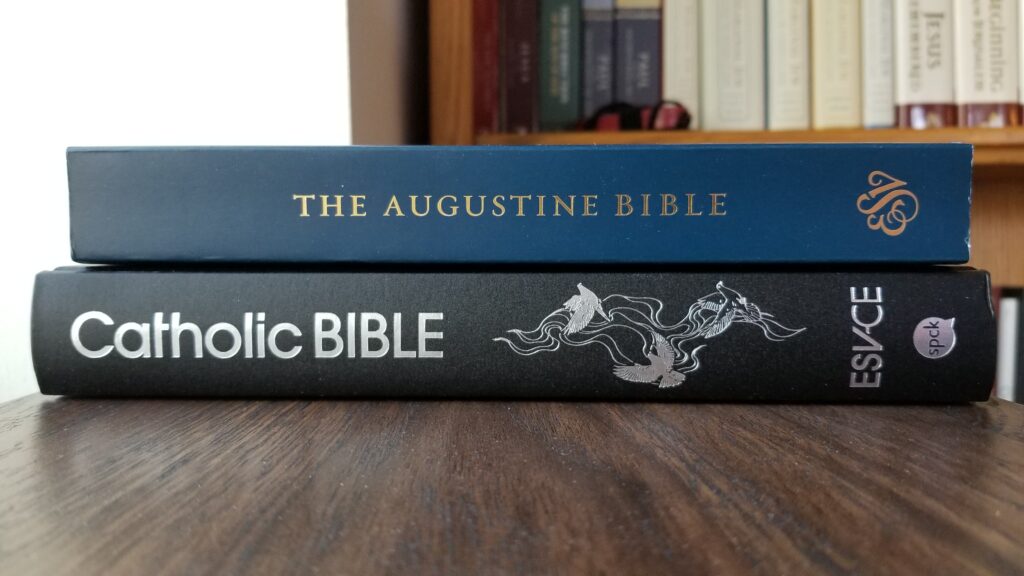
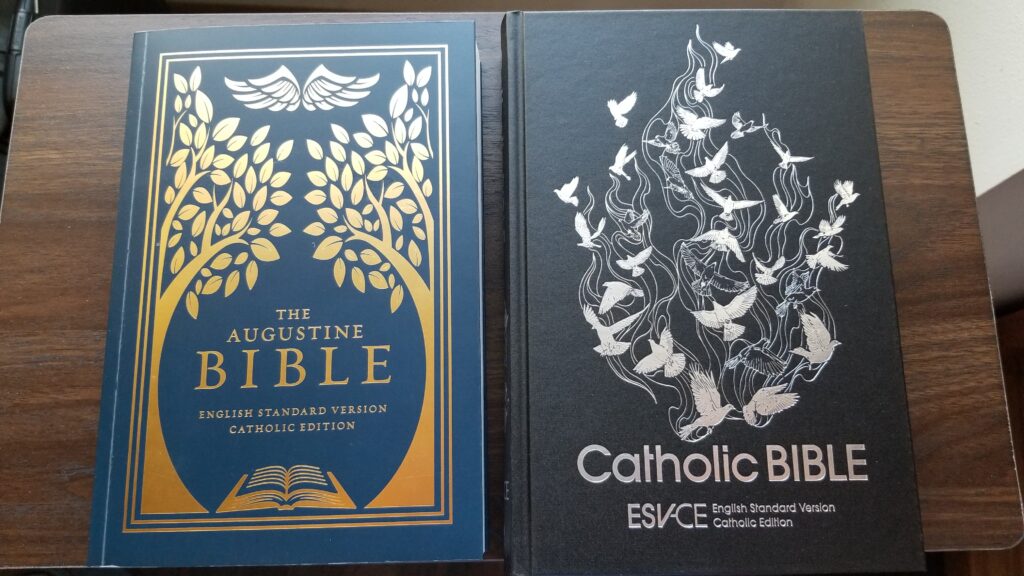

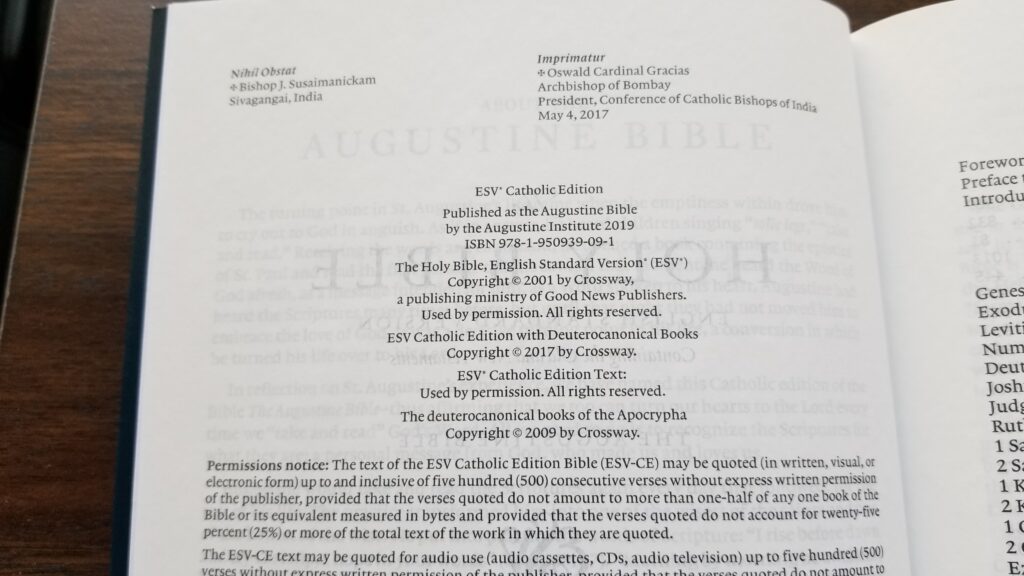
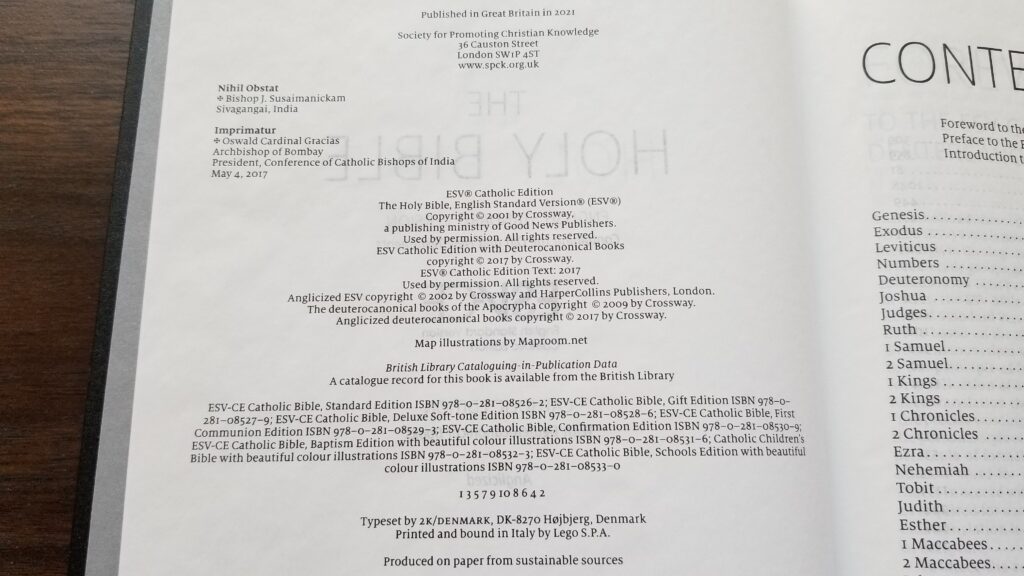
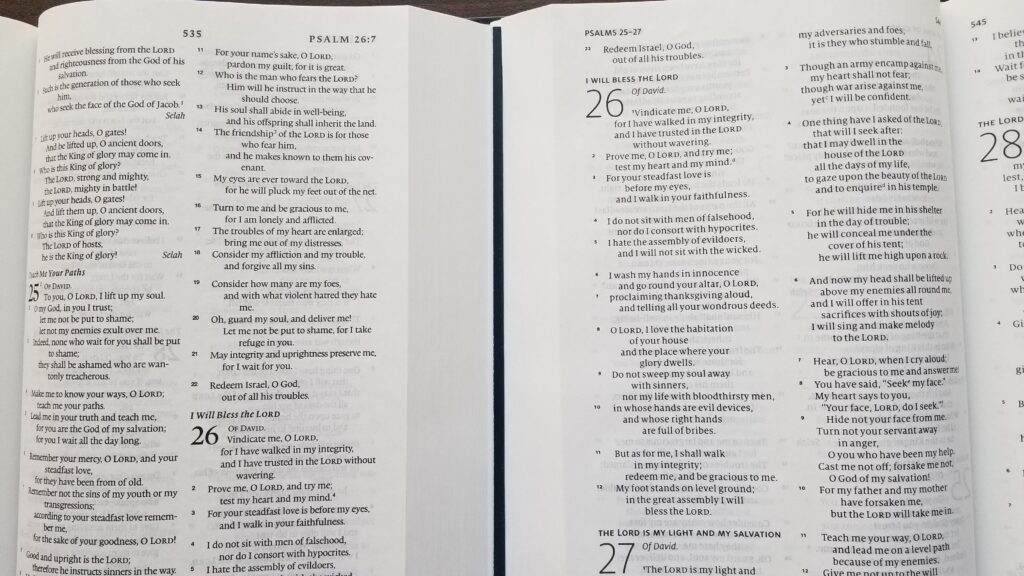
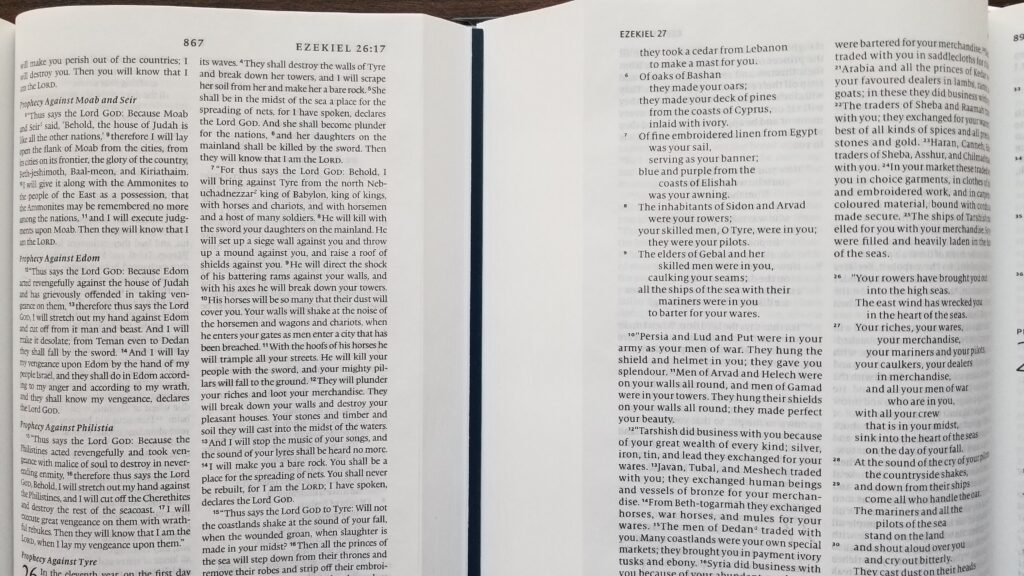
The layout of the SPCK ESV-CE is being used in the soon to be released Cambridge Cornerstone Bible in Cowhide leather which should be available sometime before July. Keeping my fingers crossed!!!
Very good to hear! I’ve held off on the ESV-CE due to my own quibbles with aspects of the translation (stemming from the regular ESV, of course) vs. the RSV (and even the NRSV), such as flatter language, a few questionable renderings, and the occasional theological situation like Luke 1:28, now that it’s the official English translation of the Catholic Church in the UK, I feel more comfortable getting it at least as an additional reference edition alongside my other English Bibles. And for that, the cowhide Cambridge Cornerstone Edition will be the one. That said, the SPCK hardcover looks good on its own, and seems like it’d be a blessing for anyone who prefers hardcover Bibles.
Question for Marc: Did the SPCK fix the typo from the original Augustine where the Foreword title was misspelled “Forword”?
I just checked, and the SPCK has the correct spelling of “Foreword.”
I ended up getting the hardcover Cambridge Diadem w/Apocrypha. Very pleased with it so far, and the Sakura 003 Pigma Micron .15mm pen works perfectly on it without bleeding through. Annotating “this book goes here”, “full of grace”, Fr. Mike’s insights, etc has been very rewarding so far.
An improvement, IMO, but I’m still not crazy about it. Don’t care for that cover, too contemporary for my taste. I’d like something with more traditional aesthetics.
Glad to see this review! I had to exchange AI’s leather version because the font size was too small and ghosting terrible and they charge so much for it, definitely not worth the price.
Picked up SPCKs ‘delux leatherette’ which is nothing but a hardcover with soft touch feel. Exchanged it and bought the hardcover version you reviewed. Saved a few bucks. It’s a nice bible with large text but ghosting is still there. Not much difference in the anglicised text. The forward is corrected in all Bibles.
Any idea when will the Cambridge ESVCE bible be releasing?
Closest copy of the Augustine Institute edition of the ESV-CE that I have is their “Bible In A Year” edition (paper back edition). If not for the daily commentaries in the AI BIAY, the SPCK hardback editions of the ESV-CE and ESV+A are a better reading edition in my books. If not that, Cambridge’s Diadem Edition of the ESV+A is also a winner too.
I was “wandering” around the internet looking for articles regarding the ESV. I came across the article below regarding the ESV. The author likes the ESV; however, he highlights problems in translation, when the translator tries to be as literal as possible. Personally, I think it is fine to use the ESV for Bible Study as it can stimulate more intensive study. If you come across something that is unclear in study, at your fingertips you can look at other translations or commentaries to potentially clear up the reading or go deeper into the Bible. (Sometimes it should be noted that a text unclear because it is unclear). I do question the use of the ESV as the source of a Lectionary (as it appears to be in the English-speaking world other than North America) as the ambo is not the time to update the language, or to explain the Greek idioms that do not always translate directly. This article is somewhat dated as it appears to be published around November 2008. The ESV was only published in the year before and has been revised in 2011 and 2016. Further, the author uses the TNIV (Today’s New International Version) as a “control” text. The TNIV was published in 2005 as an update to the NIV; however, it has been replaced by the NIV published in 2011.
I would not read this article as a criticism of the ESV but rather as the challenges in producing the best literal translation.
HTML version of the Article:
Why the English Standard Version (ESV) should not become the Standard English Version, by Mark Strauss – Better Bibles Blog (wordpress.com)
https://betterbibles.wordpress.com/2008/11/21/why-the-english-standard-version-esv-should-not-become-the-standard-english-version-by-mark-strauss/
Word/PDF Version of the Article:
https://zondervan.typepad.com/files/improvingesv2.pdf
This is great, thanks for posting it! I find Mark Strauss to be frustrating, because he dismisses “Biblish” words as being completely irrelevant and unintelligible, which I don’t think they are. He does not like, nor seem to appreciate, the approach of formal equivalence translation. Instead, his gold standard of translation is “Would anyone say this in common English today? If not, don’t translate it that way.” I find this to be far too simplistic a metric that leads to the further dumbing-down of the English language. There are many “Biblish” words and phrases that we still understand today simply /because/ the Bible has preserved them, so many people recognize them today.
All that being said, he does make some very good points, especially in regards to renderings that are half-literal or downright incorrect, which obscure or mislead the reader as to the meaning of the text.
I purchased the Anglicized ESV-CE children’s Bible (https://spckpublishing.co.uk/catholic-children-s-bible-with-beautiful-colour-illustrations-esv-ce-english-standard-version-catholic-edition-hb) and it has been a delight to read for evening family Bible reading. My only complaint is that the pictures, though very nice, are grouped together in a few different groups, rather than in the correct spot in the text associated with the picture. So you have to constantly flip to check the pictures to see if they are related to what you are reading.
Is the recently released Cambridge ESV Diadem Reference Edition with Apocrypha the same as the ESV-CE but with the books not ordered the Catholic way?
Rodolfo,
There are extremely minor textual changes in the Protocanon between the ESV and ESV-CE. They are compiled here: https://archive.azurewebsites.net/Documents/Differences%20Between%20the%20ESV%20and%20ESV-CE.pdf
To me they smack more of a copyright requirement than anything substantial.
From what I understand, though I haven’t had time to study the texts, the book of Tobit is where there are greater differences between the ESVCE and the ESV+A. It is possible that there are more variations in the deuterocanonical books because Liturgiam authenticam encouraged translators to take the same base texts as the Nova Vulgata.
Rodolfo,
The “SPCK (and Augustine) ESV-CE” has the books in the Catholic order (inclusive of the deuterocanonical books and chapters, or what Protestants refer to as the “Apocrypha”), whereas the “Cambridge Diadem with Apocrypha” (a beautiful premium bible nonetheless) has them placed in a mid-section labeled Apocrypha, which also includes books that the Orthodox Church recognizes as part of the canon (unlike the ESV-CE which does not include these, of course).
To give you an example of what that looks like, in the ESV-CE you’ll find the beautiful Daniel, chapter 3 praise verses that are considered apocryphal by Protestants, generally speaking, directly placed in proper order, from a Catholic view, in the Book of Daniel text, but in the Diadem, these verses are separate, placed in the Apocrypha section. So it just means you have to that section briefly if you want to read Daniel in its full Catholic book. This is true with a couple of other sections, too.
Thanks for this helpful review. I don’t have the SPCK edition, so I find the side-by-side comparison interesting. There are currently 5 ESV Bibles on the market with the Apocrypha/Deuterocanonical Books, and there is about to be a 6th edition as well. 1) ‘ESV with Apocrypha’ by Anglican Liturgy Press (2019), 2) ‘ESV Catholic Edition’ by The Augustine Institute (2020), 3) ‘ESV Holy Bible with Apocrypha, Anglicized’ by The Society for Promoting Christian Knowledge, UK (2021), 4) ‘ESV-CE Catholic Bible, Anglicized’ by SPCK (2021), 5), ‘ESV Diadem Reference Edition with Apocrypha’ by Cambridge University Press (2022). Cambridge University Press will be publishing a forthcoming ‘ESV-CE Catholic Bible, Cornerstone Edition’ in Burgundy Imitation Leather (ESC662:T).